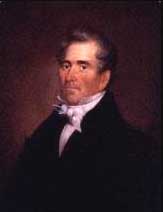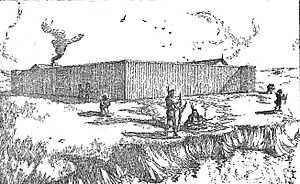Manuel Lisa facts for kids
Quick facts for kids
Manuel Lisa
|
|
|---|---|

Portrait in 1818
|
|
| Born | September 8, 1772 |
| Died | August 12, 1820 (aged 47) |
| Nationality | Spanish, American |
| Other names | Manuel de Lisa |
| Occupation | land owner, merchant, fur trader, Indian agent, explorer |
| Employer | Missouri Fur Company, US Government |
| Known for | Spanish American frontiersman, who was co-owner of the Missouri Fur Company and as a United States Indian agent, during the War of 1812, helped to pacify the Teton Sioux, Omaha and Ponca Nations and keep them loyal, in wartime, to America. |
| Spouse(s) | 1) Polly Charles Chew; 2) Mitane (Meetahnay); and 3) Mary Hempstead Keeney |
| Children | 1) children; 2) Rosalie and Christopher; and 3) no children |
| Signature | |
 |
|
Manuel Lisa, also known as Manuel de Lisa (born September 8, 1772, in New Orleans, Louisiana (New Spain) – died August 12, 1820, in St. Louis, Missouri), was an important figure on the American frontier. He started as a Spanish citizen and later became an American citizen. Manuel Lisa was a landowner, merchant, fur trader, and explorer. He also worked as a United States Indian agent.
Lisa was one of the people who started the Missouri Fur Company in St. Louis. This was one of the first fur trading companies in the area. He earned a lot of respect by trading with Native American tribes in the upper Missouri River region. These tribes included the Teton Sioux, Omaha, and Ponca peoples.
During the War of 1812, Lisa was made a US Indian agent. He used his good relationships with the tribes to encourage them to support the United States. He also helped them fight against tribes that were allied with the United Kingdom. In 1814, Lisa married Mitane, who was the daughter of Big Elk. Big Elk was the main chief of the Omaha people. This marriage helped to make their alliance stronger. Lisa made sure that his children with Mitane were cared for in his will, just like his children from his other marriage.
Contents
Early life and beginnings
Not much is known about Manuel Lisa's early life. He was likely born in 1772 in New Orleans, which was then part of Spanish Louisiana. His father, Christoval de Lisa, came from Murcia, Spain. His mother, Maria Ignacia Rodriguez, was from a colonial family in St. Augustine, Florida.
Manuel Lisa and his brother Joaquin started trading on the Mississippi River by 1789. They were active in places like New Madrid, Missouri. Lisa quickly became involved in the fur trade, which was a big part of the economy in the region.
Family and important alliances
By 1796, Manuel Lisa married Polly Charles Chew, a widow from New Orleans. They moved to St. Louis, which was a busy center for the fur trade. Polly Lisa stayed in the city with their three children while Manuel went on long trips to trade with Native American tribes.
Around 1813, Lisa built Fort Lisa in what is now Omaha, Nebraska. He worked hard to make alliances with local tribes, like the Omaha. In 1814, the governor of the Missouri Territory made Lisa a US Indian agent for the area. To strengthen ties, Lisa married Mitane, a daughter of Big Elk, the main chief of the Omaha. This was seen as a smart move by both sides. Lisa and Mitane had two children, Rosalie and Christopher.
Relationships through marriage were very helpful for traders. They provided power and were often needed for success in the fur trade. Chiefs often saw these marriages as a way to increase their own power.
Polly Chew Lisa died in 1817 while Manuel was away. When he returned in 1818, Lisa married Mary Hempstead Keeny. She was a widow and the sister of his friend, attorney Edward Hempstead. In 1819, Lisa took Mary with him to Fort Lisa in Nebraska. He tried to get custody of his children with Mitane. She allowed him to take Rosalie back to St. Louis for school, but Christopher stayed with her. Lisa made sure to include both Rosalie and Christopher in his will, along with his children from his first wife.
Early trading trips
Manuel Lisa moved to St. Louis to join the fur trade. By 1802, he had a special trading agreement with the Osage Nation. This agreement had been held by Auguste Chouteau before. However, after the Louisiana Purchase, Lisa's relationship with the new US government was not as strong. He faced competition from Pierre Chouteau, who was also a US Indian agent.
Lisa had some difficulties with James Wilkinson, who was the governor of the US Louisiana Territory. Wilkinson stopped Lisa's plans to create trade routes to Santa Fe, New Mexico, which was still under Spanish rule.
Because of these challenges, Lisa decided to organize a trading trip to the upper Missouri River region. In April 1807, Lisa and 42 men traveled up the Missouri River. They reached the Yellowstone River and then went up the Yellowstone for about 170 miles. On November 21, he set up a trading post at the mouth of the Bighorn River in present-day Montana. This post was called Fort Raymond (also known as Fort Manuel). It was the first trading post in the upper Missouri area.
Lisa sent John Colter to explore the region and trade with the Blackfeet tribe. Colter became the first known European to visit what is now Yellowstone National Park. He reported on the amazing geothermal features there.
In July 1808, after a good trading season, Lisa left Fort Raymond. He left a small group of men behind for the winter. The trading post was profitable but was often attacked by the Blackfeet. During these years, Lisa's wife Polly and their children stayed in St. Louis.
Starting the Missouri Fur Company
When Lisa returned to St. Louis in August 1808, he helped create the Missouri Fur Company. This was a joint business with other important fur traders from St. Louis. These included Jean Pierre Chouteau, Pierre Chouteau, Jr., and William Clark. The company was set up to last for three years.
In the spring of 1809, Lisa went back upriver with a large group of 350 men. They had 13 boats filled with supplies for trading. The trip up the Missouri River was slow. Lisa moved the goods from Fort Raymond to the new company and left the old, isolated post.
Lisa then built the first Fort Lisa (also called Fort Manuel) near what is now Bismarck, North Dakota. It was close to a Gros Ventres village. After the new fort was built, Lisa returned to St. Louis in October 1809. He continued to manage trading operations from this fort.
In April 1811, Lisa began another important trip. He aimed to find the fur trader Andrew Henry and bring the remaining goods from Fort Lisa back to St. Louis. This trip became famous because Lisa's boats caught up to a rival expedition led by William Price Hunt. Lisa stayed with the Mandan and Arikara tribes until Henry came downriver. They both returned to St. Louis at the end of 1811.
When the Missouri Fur Company was reorganized in 1811-1812, Lisa became a more important leader. He built a brick home in St. Louis, showing his success. In May 1812, Lisa went upriver to Fort Lisa again. He was at Fort Lisa in North Dakota when Sacagawea, the famous interpreter and guide for the Lewis and Clark Expedition, died there on December 20, 1812. She was buried at the fort.
On this journey, Lisa also set up a new fort further downriver, also called Fort Lisa, in what is now Omaha, Nebraska. Lisa became the first known United States settler of Nebraska. His outpost became very important and helped the city of Omaha grow.
Manuel Lisa and the War of 1812
In June 1812, the U.S. Congress declared war on the United Kingdom. When Lisa returned to St. Louis in 1813, people were worried that British agents would encourage Native American tribes to attack American settlements. The war made fur trading difficult. In 1813, British and Native American allies burned Fort Lisa in North Dakota. Lisa, like other traders, had to stop his operations during the war.
In early 1814, William Clark, the governor of the Missouri Territory, appointed Lisa as a US Indian Agent. His job was to work with the tribes above the mouth of the Kansas River. Lisa went to Fort Lisa in Nebraska. There, he helped create alliances between the United States and tribes like the Omaha and Ponca. He was especially good at working with the Teton Sioux. He encouraged them to fight against tribes that were allied with the British.
The U.S. government later praised Lisa for his "great service in preventing British influence" in the northern areas. After the war ended in 1815, Lisa continued his yearly trading trips. He spent each winter at Fort Lisa, Nebraska. He had two children with Mitain: Rosalie and Christopher.
Later life and legacy
After the War of 1812, Lisa's reputation in St. Louis improved. This was because of his success in the fur trade and his help to the Americans. In 1815, he invited 43 Native American chiefs from different tribes to St. Louis. He entertained them for about three weeks to strengthen their friendship with the Americans. They met with US officials to sign peace treaties.
In St. Louis, Lisa was seen as an ally of the important families. He became friends with leading American figures, including attorney Edward Hempstead. In the fall of 1817, his first wife, Polly Lisa, died while he was on a trip.
In 1818, Lisa was among the many people in St. Louis who welcomed Bishop Louis William Du Bourg. The Bishop decided to make St. Louis the main city for his church area. Lisa and other families promised money to build a new church. On August 5, 1818, Lisa married Mary Hempstead Keeny, Edward Hempstead's sister. Pierre Chouteau, another important fur trader, was a witness at his wedding.
After living in St. Louis for a year, Lisa took Mary with him to Fort Lisa in Nebraska for the winter of 1819-1820. Mary Lisa was likely the first European-American woman to travel so far up the Missouri River.
By 1819, Lisa had built strong relationships with many tribes, including the Omaha, Ponca, Yankton, Teton Sioux, Mandan, and Arikara peoples. He played a key role in expanding trade from St. Louis all the way to the Yellowstone and Bighorn rivers. He reached tribes that had been more influenced by the British before.
Manuel Lisa returned to St. Louis in April 1820. He soon became ill and died on August 12, 1820, at Sulphur Springs, which is now part of St. Louis. He was buried at Bellefontaine Cemetery. His will set aside money for his children, including those with Mitain.
After Lisa's death, the Missouri Fur Company continued for a while under new leadership. However, the fur trade began to decline. By 1830, John Jacob Astor's American Fur Company had become very powerful, and the Missouri Fur Company eventually closed.
Images for kids
See also
 In Spanish: Manuel Lisa para niños
In Spanish: Manuel Lisa para niños





